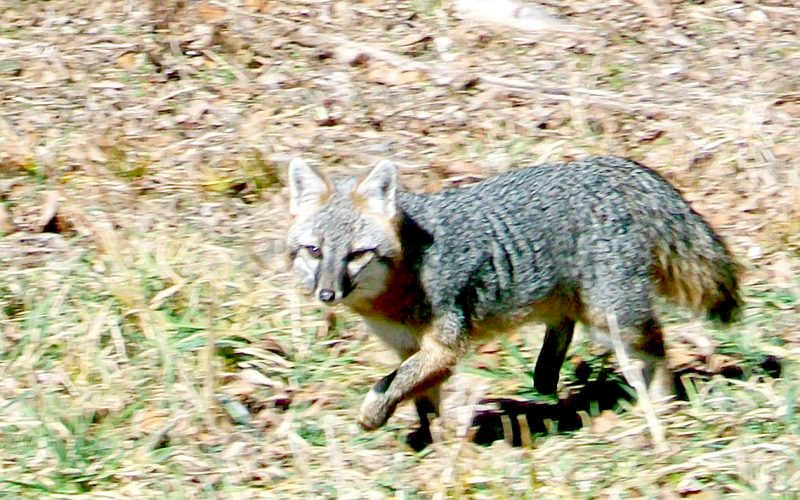
Staff Photo Amanda Bancroft
A rare Arkansas grey fox is spotted in an open field. The cousin to the red fox is known for their ability to climb trees with their hooked claws.
It’s usually the red fox (Vulpes vulpes) that gets all the fame in popular culture. But its shorter relative, the grey fox (Urocyon cinereoargenteus), has an interesting life worthy of our notice. How often do you look for a fox in the same places and at the same times as you would look for an owl?
Grey foxes have the unique ability among American canids to climb trees thanks to their strong, hooked claws. When descending a tree, they can go down backwards like a cat. They’re most likely to escape up a tree rather than run away when threatened, and their dens can be up to 30 feet high in a hollow. Sometimes they adopt another animal’s underground burrow, and rarely dig their own dens. Their reliance on trees makes them favor forest over field, unlike the red fox which loves open spaces and has benefited from human development and deforestation.
Red foxes have longer legs, which are always black regardless of what color phase the coat is, and more slender bodies than the grey fox’s stockier build. Silver foxes (a gray phase of the red) may resemble the grey fox in fur, but their body shapes are different and silver foxes keep the characteristic white tail tip while grey foxes have a black or dark tail tip. Oddly enough, grey fox pupils are oval in shape rather than slits like all other foxes.
Although they are carnivorous canids (members of the dog family), they eat a somewhat omnivorous diet of meat, insects and fruits like our local persimmons. In some regions, their diet is mostly insects and plant foods! But they usually prey on mice, voles, shrews, cottontail rabbits, birds, rats, and squirrels. Only rarely do they kill poultry – rodents make up the majority of their diet. Because of their smaller size, they can find themselves on the menu for coyotes, red foxes, mountain lions and wolves. Because they’re nocturnal like many of their prey species, they usually hunt at night but can occasionally be seen foraging during the daytime (especially now, during their mating season).
Like other foxes, the grey fox is monogamous and a mated pair stays together to raise the kits. The mating season in Arkansas begins in mid-January and peaks in February. Females can give birth as early as March. Litter size averages four kits but has been known to be as large as ten. By autumn, the kits have reached sexual maturity and strike out on their own as adults.
Their life span is typically half a decade, and foxes reproduce earlier and have more young than wolves possibly due to the fact that foxes live much shorter lives than wolves. According to “The Lives of Wolves, Coyotes and Foxes” by Stan Tekiela, the longest-lived fox in the wild was 12 years old. Although it’s incredibly rare to spot one, time spent in nature and preservation of our native forests are two good ways to increase our chances of having a privileged encounter with a grey fox.
Amanda Bancroft is a Master Naturalist and volunteers with her husband Ryan for their solar-powered online educational center on how to make a difference with everyday choices at: www.RipplesBlog.org.










